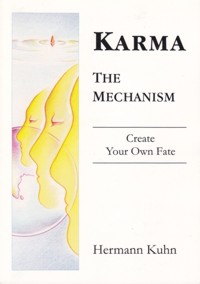4 - In the fourth stage (avirata-samyaktva)
we reach a clear, intuitive and true understanding of the mechanisms of this world. We are no longer subjected to the strongest form of negative passionate emotions that previously overshadowed us completely, yet our life can still be impeded considerably by the three lesser intense degrees. We make some efforts to gain freedom from karmic limitations, but do not raise sufficient energy for reaching the fifth gunasthana (desavirata).
In this stage we still are subject to doubt and to the attachment or rejection of material objects. In the first two phases of this stage we can lose our clear understanding (our intuitive orientation towards growth) again. In this case we fall to the third stage (misra - mixed truth and delusion), from where we may rise again to the fourth level or - passing through the second level - fall down to the first stage of total delusion.
The fourth gunasthana is reached directly from the first stage - without any intermediary steps.
We experience this stage in three phases which differ significantly in their clarity of understanding. The differing character of these phases is caused by the length of time we stay in them.
- The first phase is characterized by fleetingness.
At the first occurrence of this phase all karma (all our emotional attachments to the restrictive mechanisms of level 1) that previously prevented the shift of our awareness to level four becomes inactive (latent) for a short time.
We experience this as brief periods during which all our desires, preoccupations, prejudices and attachments that bonded us to the dense hypnotic envelope of level one cease to engage our attention. It feels as if we all of a sudden wake up from a deep day-dream that the hustle-bustle of daily life constantly weaves around our consciousness.
Yet though we experience this awakening with extraordinary clarity, our desire for the emotional density on level one is so intense that after a brief time (initially after only fractions of seconds, at most after 48 minutes) we fall down to level three, two or one. As long as we do not direct our attention towards these moments of awakening, they continue to be so evanescent that only fleeting impressions remain.
Once we direct attention towards these insights, they lose their fleeting character. In consequence the initial stark contrast to the hypnotic envelope of level one diminishes. We begin to notice that we lose ourselves less and less in the actions we are involved in. The clarity in our life increases and we become able to steer it more consciously. Eventually we exceed the maximum time we can stay in this phase and thereby automatically advance to phase two.
- During the second phase some part of the karma that had only become inactive (latent) in the first phase, dissolves completely. We begin to understand the limiting character of some of our attachments, desires and beliefs that trapped us on level one. We stop refueling these bonds with new energy and attention and in consequence they cease to influence us a short while later. This automatically lengthens the periods during which we are free from the hypnotic envelope that overshadowed our consciousness on level one.
Yet since not all blocking karma has been dissolved, we still lose this state of clarity from time to time. The emotions that then draw us to the lowest level can be so overpowering that we again become fully entangled in the hypnotic cocoon of level 1. In this case we may easily forget the clarity of stage 4 or think it irrelevant and will certainly not attempt to regain the higher state.
When - at the end of this phase - all obstructing karma (i.e. all preoccupations that attached our consciousness to the hypnotic envelope of level one) dissolves, we enter phase three.
- In the third and stable phase of stage four no karmic bonds are able to totally impede the clarity of our understanding any more. To what extent we can put our new insights into action depends on the amount of energy we invest in our further growth. To raise sufficient energy for reaching the next gunasthana is the basic challenge we face in this third phase.
The transition from phase two to three is so gradual that we become hardly aware of it. Since in phase two we already experienced long stretches of inner clarity, we barely notice that we do not fall back to level one any more. No special experience marks this particular transition other than that the silver lining of awareness of ourselves never disappears again. We might e.g. still feel intense anger, but in contrast to level one now a detached observer in our head always judges our actions and emotions with impartiality, distance and clarity. We now know without fail when we do something detrimental to our growth (and still keep on doing it). But we also recognize clearly the activities and attitudes that enhance our growth. The more we listen to this impartial part of us that became aware of itself on this level, and the more we dare to transform our insights into action, the faster higher stages open up.
Though at this point we may feel unsure which activities will further our growth, this insight comes to us the faster the more we desire further progress.
Once we reach this stable phase of stage four, we never fall down to any of the lower gunasthanas any more. The far more comprehensive understanding of stage four automatically dissolves all our emotional attachment to the themes (karmas) of stage one to three, which then dissipate without manifesting much of an effect.
It is possible to reach this stable phase within one year. It only depends on the sincerity of our interest and the amount of energy we invest in this venture.
Yet this stable phase of stage four has a highly static character. We now can easily get trapped in a complacency that prevents our ascent to higher levels as intensely as the dense emotional cocoon that trapped us on stage one.[1] We now know what feelings and activities we need to change, but decline to transfer this insight into action. Yet if we do not raise the additional energy required for further progress, our stay in the fourth stage will last eternally.
The rise to the fifth stage (desavirata) only becomes possible when a strong and dynamic desire for further development exists that is also transformed into action. Activity is the main key that will tilt our life towards the higher stages. Only when we concentrate considerable energy on transferring our insights into decisions and concrete action do we become able to break the karmic stagnation of level four.
Any attempt to orient our life along the Five Freedoms[2] helps to set further development in motion. Yet in contrast to a wide-spread interpretation taking a purely formal vow to practice the Five Freedoms is not sufficient to cause the transfer of our awareness to level five.
Yet in reality this is stagnancy. What is lacking are the sweeping breakthroughs, the dynamic unfoldment of higher stages, the pronounced transition into far superior levels of our being. Though we might well gain insights in this static phase, we basically are unwilling to raise the energy necessary for any breakthrough to higher stages.
 Hermann Kuhn
Hermann Kuhn
